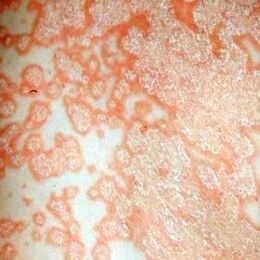
Psoriasis is a chronic, non-infectious skin disease. This disease is recurrent. In very rare cases, psoriasis can affect the joints, nails and mucous membranes. People of all ages are susceptible to psoriasis. According to statistics, there was a tendency to develop the disease in childhood.
Psoriasis is not necessarily a chronic infectious disease. Most dermatologists believe that psoriasis is a systemic disease. According to them, the disease affects not only a certain area of the skin, but also almost all systems of the body (endocrine, immune, nervous) in the pathological process.
From the outside, it may seem that psoriasis is a mild disease. But in fact it is far from this situation. The disease is dangerous. Deaths are known in dermatology. When treated prematurely or incorrectly, psoriasis affects the entire body, leading to serious complications. For example:
- psoriatic arthritis
- swollen lymph nodes
- conjunctivitis
- mucosal damage
- straightening and damage to the nail plates
- spontaneous pain
- amiotrophy
- in rare cases - heart damage
As a rule, psoriasis does not disrupt the normal rhythm of life of a sick person. The only concern is peeling and inflammation of the skin. Unfortunately, it is not possible to get rid of this disease, but it is quite possible to stop its development or prevent a relapse. It is enough to follow all the doctor's prescriptions and receive systematic treatment in the hospital.
Causes of psoriasis
There is no specific reason for the onset of the disease. There are many factors that can lead to the development of psoriasis. There is no unequivocal opinion in dermatology about this or that cause. There are many versions. Most dermatologists believe that the disease is genetically predisposed. It is impossible to unequivocally confirm or deny that heredity is the root cause. There are cases when the whole family has psoriasis.
In other words, if a mother has psoriasis, then her child does not necessarily have to show signs of the disease. However, it is impossible to rule out genetic predisposition. For example, if a grandmother suffers from this disease, it is possible that grandchildren will never be diagnosed with psoriasis. The question of the causes of the development of the disease at the genetic level remains open to this day.
According to many dermatologists, the next factor that can provoke the appearance of psoriasis is diseases of the endocrine system. For example, adrenal dysfunction, diabetes mellitus, pituitary dysfunction. The proportion of symptoms of psoriatic disease is very high in people suffering from pathologies of the endocrine system. For this reason, there is a link between diseases and it has been proven by numerous examples.
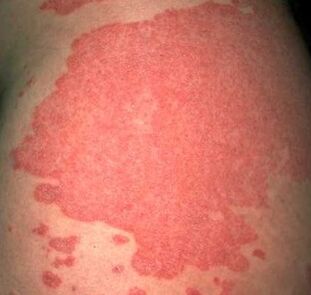
In addition to the reasons mentioned above, there are many endogenous factors. For example:
- Delayed diseases of an infectious nature, such as tonsillitis. According to statistics, 17% of patients surveyed believe that psoriasis is a complication of angina.
- Chronic infectious pathological processes, such as laryngitis or tonsillitis, can also cause psoriatic disease.
- Long-term use of certain drugs: interferons, NSAIDs, beta-blockers, etc.
- Strange as it may sound, pregnancy can also lead to the development of psoriasis. Significant hormonal changes occur in a woman's body, often triggering a pathological process that lies in the body.
- It is impossible to rule out the negative effects of excessive ultraviolet radiation on the human body, ie prolonged exposure to the hot sun or frequent visits to the solarium.
Of course, in addition to endogenous factors, there are a number of exogenous causes. For example, skin diseases (dermatitis, mycosis, pyoderma), mechanical damage to the integrity of the skin, allergic dermatitis.
An interesting fact. Psoriasis is significantly more prevalent in HIV-infected people than in healthy people. It is important to note that women are more susceptible to psoriatic disease than the male population. Dry, thinned and sensitive skin is another tendency.
You should know that if a person's immune system is compromised, then it often causes pathological psoriasis. Immune disorders and psoriatic disease are closely linked.
There are many causes of psoriasis, but there is no single cause that can completely lead to the development of the disease.
Types and forms of pearls
Psoriasis is a multifactorial disease. According to statistics, people generally suffer from only one type of psoriasis each time. However, there are cases when a person has several types of psoriasis at the same time. Frequent and convenient transfer of one type of psoriasis to another in dermatological practice. Such a "rebirth", as a rule, leads to a sharp cessation of prescribed treatment.
There are two main groups of types of psoriasis in dermatology: non-pustular and pustular.
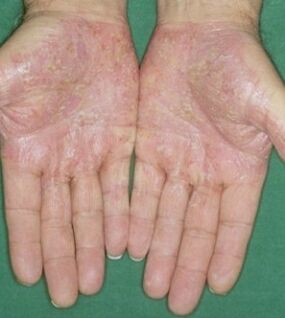
Pustular forms- Barbera psoriasis, psoriasis of the soles and palms (see photo), Tsumbusha psoriasis, ring pustulosis. This form of psoriasis is conventionally divided into generalized and localized. The last pustular psoriasis can be anywhere on the skin. There are cases of pustules on the plaques in psoriasis vulgaris.
Allopo acrodermatitis can be considered as an independent example of the disease. As a rule, the disease is characterized by pustules and lesions of the shell of the fingers and distal phalanges of the fingers. Another example of an independent disease of a localized form of psoriasis is pustular psoriasis of the bases and palms. It is important to note that some dermatologists believe that this disease is a pustular bactericidal form.
Generalized pustular psoriasis includes:
- herpetiform impetigo,
- psoriasis Tsumbusha,
- exanthema generalized psoriasis.
As a rule, men aged 15-35 suffer from Tsumbush psoriasis. This disease is less common in women.
Exanthemic pustular psoriasis occurs suddenly (suddenly) and sharply. In most cases, there is a close relationship with other infectious diseases, such as tonsillitis. The spill is mainly localized on the highway. More children, adolescents are more susceptible to the disease, less adults.
Herpetiform impetigo is a serious disease that can be fatal. As a rule, this disease is characteristic of pregnant women, especially in the second trimester. However, in dermatological practice, it is still extremely rare in men, non-pregnant women and children.
Non-pustular psoriasis. . . In other words, we can say a simple psoriasis. This form of the disease differs from others with a stable course. For the non-pustular form of psoriasis, almost the entire surface of the body is affected. These types include:
- erythrodermic psoriasis
- psoriasis vulgaris, or plain or plaque.
Common psoriasis is very common, with up to 90% of psoriasis patients having a vulgar form of the disease.
Psoriatic erythroderma is a serious disease that often leads to a fatal outcome - the death of the patient. With the disease, there is a violation of thermoregulatory function and a decrease in the barrier function of the skin. These pathologies cause pyoderma or sepsis.
Classification and symptoms of psoriasis
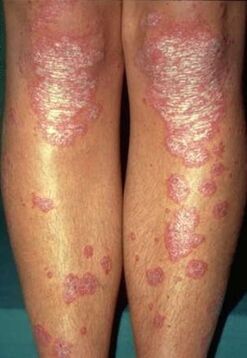
There is no single classification of psoriasis that is generally accepted by dermatologists. There is still controversy over how to classify this skin disease. Some sources have their own list of psoriasis forms. The most common classification of the disease:
- Guttate psoriasis
- Pustular psoriasis
- Psoriatic onychia
- Psoriasis of the mucous membranes
- Exudative psoriasis
- Psoriasis of the soles and palms
- Arthropathic psoriasis
- Intertriginous psoriasis
- Psoriatic erythroderma
- Seborrheic psoriasis
- Weak psoriasis
- Pustular bacteria
- Tsumbusha psoriasis
Arthropathic psoriasisat first it is almost asymptomatic. Patients sometimes report only a slight pain in the joints. Over time, the pain intensifies, becomes sharper and sharper. Affected joints swell. If the disease is not treated, the joints become deformed and there is a restriction in mobility. As a rule, arthropathic psoriasis is often accompanied by rheumatoid type pain. In winter, there is a complication of the disease, which is seasonal for such psoriasis.
Pustular psoriasis. . . It is not uncommon, and only 1% of the total number of patients with psoriasis falls on this type of disease. In most cases, the rash is symmetrical and localized on the feet and palms. Pustular psoriasis is generalized and localized. The latter form is more common than the former. Generalized pustular psoriasis is difficult. In dermatology, deaths from sepsis and severe intoxication are common.
Psoriatic erythroderma. . . Severe psoriasis caused by exacerbation of pre-existing psoriasis. This disease can be the result of exacerbation of the underlying disease, as well as the first appearance. Secondary erythroderma psoriatic, as a rule, develops in 2% of those who suffer from this disease.
Often, the disease occurs spontaneously, but in the acute period of the disease, psoriasis can not be ruled out as a result of proper, irritating treatment of dermatosis. Patients report an increase in pathological foci of desquamation, an increase in temperature, and dehydration. In dermatological practice, there have been deaths from psoriatic erythroderma.
Guttate psoriasis- The second most common disease among all forms of psoriasis, children and adolescents suffer more often. The skin is characterized by the appearance of a large number of dry, purple and small elements that rise slightly above the surface of the ineffective skin. The rash is in the form of drops, circles or tears. As a rule, the elements cover the entire human body, but most are "localized" in the thighs. In most cases, the appearance of psoriasis in the form of tears causes a streptococcal infection. For example, streptococcal sore throat, streptococcal pharyngitis.
Psoriatic onychia. . . The disease is characterized by different changes in the appearance of the nail plate, both on the hands and feet. First of all, the color of the nail changes, sometimes the nail bed is together. The nail is gray, yellow or whitish. On the nails, sometimes spots or small spots appear under the nail plate itself. The nail plate thickens, striae and brittleness appear. Another clinical manifestation of the disease is the thickening of the skin around the nail bed. A difficult consequence of psoriatic onychia is the spontaneous loss of the nail.
Psoriasis of the mucous membranes- is a type of pustular psoriasis or psoriasis vulgaris. The mucous membranes of the cheeks, tongue and lips are often affected, and to a lesser extent the mucous membranes of the genitals and eyes. With the pustular form of psoriasis, the rash is more extensive, a large area of the mucous membrane is affected, and geographic glossitis is noted. In normal psoriasis, straight white-gray papules with clear borders appear on the unaffected surface of the mucous membranes.
Psoriasis of the soles and palms. . . The disease is a localized form of pustular psoriasis. As a rule, this form is chronic and recurrent. In dermatology, there are cases where Barbera's psoriasis continues at the same time as plaque psoriasis. Pustules appear on the inner surface of the hands and / or feet. Vesicles dry out over time and under the influence of medical therapy. Such dried elements then form dense brown crusts.
Intertrigue psoriasis. . . The disease is mainly characterized by the appearance of rashes on the skin wrinkles. For example, the intergluteal, the wrinkles between the fingers, the groin, the armpits, and the area under the mammary gland. Interstitial psoriasis is more common in patients with diabetes, VSD (vegetative-vascular dystonia), obesity, who do not follow simple hygiene rules.
Wrinkles form erosive and weeping erythematous-papular edema foci. An important feature of the elements of this disease is the separation along the periphery of the stratum corneum. Intertrigue psoriasis is very similar to epidermophytosis, candidiasis or rubromycosis. It is important to note that the clinical picture of candidiasis or dermatomycosis is brighter and sharper than that of psoriasis.
Seborrheic psoriasis. . . In terms of symptoms, seborrheic psoriasis is very similar to seborrheic eczema. As a rule, psoriatic rash has the same localization as the elements with seborrheic eczema. Can be:
- nasolabial folds
- scalp
- ear to ear
- chest area
- intercapular region
With seborrheic psoriasis, there are areas where the skin on the head is severely peeled. An important feature of this disease is the formation of a kind of psoriasis crown. Damage to the skin occurs on the forehead and spreads evenly on the scalp, so the contours of the crown are simply visible. It should be noted that dandruff is an alarm signal that "speaks" of the development of seborrheic psoriasis.
Behind the auricle, as a rule, red eczema occurs, and purulent crusts often fold. Gray-yellow scales are characteristic of localized rashes on the chest and face. A psoriatic rash always causes severe itching. It is important to note that seborrheic psoriasis is difficult to diagnose because it is often confused with seborrhea.
Exudative psoriasis. . . This type of psoriasis is more common in children and the elderly. Patients with disorders of the endocrine and immune systems have a very high risk of developing this disease. Exudative psoriasis often affects the healthy skin of overweight or diabetic people.
The disease is characterized by excessive accumulation of exudate in the papule, which gradually forms yellowish crusts. If the shells are removed, a weeping and bleeding surface appears. The scales dry over time and stretch on top of each other, thus forming a fairly dense and massive conglomerate.
The main feature of exudative psoriasis is the clear localization of pathological foci. As a rule, the lower extremities and large wrinkles are most affected. The rash gives a person the strongest itching and burning sensation. The clinical picture of this disease is sharp and acute.
Weak psoriasis. . . Different sources have different names. For example, a plaque, ordinary, simple. This type of psoriasis ranks first in terms of prevalence - it is observed in almost 90% of patients with psoriasis. The disease usually begins quite acutely. The first symptoms appear almost immediately.
Vulgar psoriasis is characterized by the appearance of typical elements that rise slightly above the inactive parts of the skin. The rash is inflamed, red and hot to the touch. The elements are thickened, covered with a silvery-white, scaly, dry film (leather), easily peeled off.
You should know that the gray shells are easily removed, causing damage to the lower layer of the papule, which is equipped with numerous small vessels. This usually results in a small incision. In dermatology, affected lesions are called psoriatic plaques.
Such boards have a tendency to coalesce, which leads to an increase in their size. Over time, plaques with a unique name are formed - "paraffin lakes". Common psoriatic eruptions with psoriasis are quite costly. Treatment is long, requires inpatient treatment.
Pustular bacteria. . . According to statistics, the disease occurs mainly in young people (from 20 years) and middle (up to 50 years). The exact etiology of pustular bacterium has not been determined. There is a hypothesis that the disease develops against the background of a strong and long-term allergy associated with infectious foci. For example, toothache, tonsillitis or tonsillitis.
Psoriatic eruptions affect the skin of the palms and soles. Pustular bacteremia is chronic, recurrent. The first tricks appear, if in the palms, then in the center, on the sole, then on the arch. Primary psoriatic elements are small, not exceeding the size of the head of a pin. Over time, the pustules dry out and form lamellar crusts. Patients experience severe itching and pain in the affected areas.
The paroxysmal course of the disease is characteristic of pustular bacterium. At the same time, inflammation occurs in all areas affected by psoriasis. Gradually, psoriatic foci increase, and after a few weeks, almost the entire surface of the palm or sole is involved in the pathological process. As a rule, pustular bacteria last for years and persist with persistent relapses.
Nutrition for psoriasis
Patients with psoriasis should simply follow a diet and follow the basic principles of proper nutrition. The main task of the diet is to maintain a normal acid-base balance. However, it is important that the body's alkaline background is slightly superior to the acid.
Of course, the balance of the body depends on the foods that psoriasis patients eat on a daily basis. It is important to know that for every person suffering from this disease, 70% of the daily diet should be at the expense of alkaline products in the body. For acid-forming - no more than 30%. To put it simply, alkaline products should be consumed 4 times more than acid-forming ones.
List of alkaline products in the body:
- Any vegetable except rhubarb, pumpkin and Brussels sprouts. It is important to remember that potatoes, peppers, eggplants and tomatoes are strictly forbidden.
- Fruit should not be excluded. The main thing is not to use plums, cranberries, currants and blueberries. It should be noted that bananas, melons and apples should not be consumed at the same time as other foods.
- Make sure you drink fresh vegetable juices from carrots, beets, parsley, celery and spinach.
- Juices from grapes, pineapples, pears, oranges, papayas and grapefruits, mangoes, lemons and apricots can be consumed daily. It is important to add lemon juice to your food.

List of foods that psoriasis patients are forbidden to eat (forms acid):
- You should completely eliminate or minimize the consumption of foods that contain starch, fat, sugar and fat. Typically, these include the following foods: potatoes, beans, cream, cheese, grains, meat, dried peas. An unbalanced daily intake of these products inevitably leads to the onset of acid reactions in the blood. The result is a deterioration in well-being.
- It is important to balance your diet properly. There are also a number of foods that are banned. For example, meat products with high sugar content and sweets and starches should not be combined.
- It is important to limit sugar intake. Preservatives, vinegar, dyes and various food additives should be included in the diet as little as possible.
- The main thing is to completely exclude the consumption of alcohol and alcoholic beverages.
Every psoriasis patient should remember that proper nutrition is an important condition in the treatment of this disease. It is important to replace the frying with stewing or boiling. It is necessary to eat soft foods.
Psoriasis treatment
Treatment of psoriasis should be carried out in an acute setting in a hospital setting and in remission in an outpatient setting. Diet is an important point in treatment. Fasting days are useful.
In addition to diet and specialized treatments, it is important to carefully monitor skin hygiene. It is best to use resin soap for washing, you can also use baby soap. As often as possible you should take a bath with a decoction of celandine, purple tricolor or hops.
If there are no contraindications, you can try to treat psoriasis and folk remedies. Practice and self-medicate. Only a doctor has the right to advise which folk remedies are useful and necessary.
List of safe and effective ointments for psoriasis:
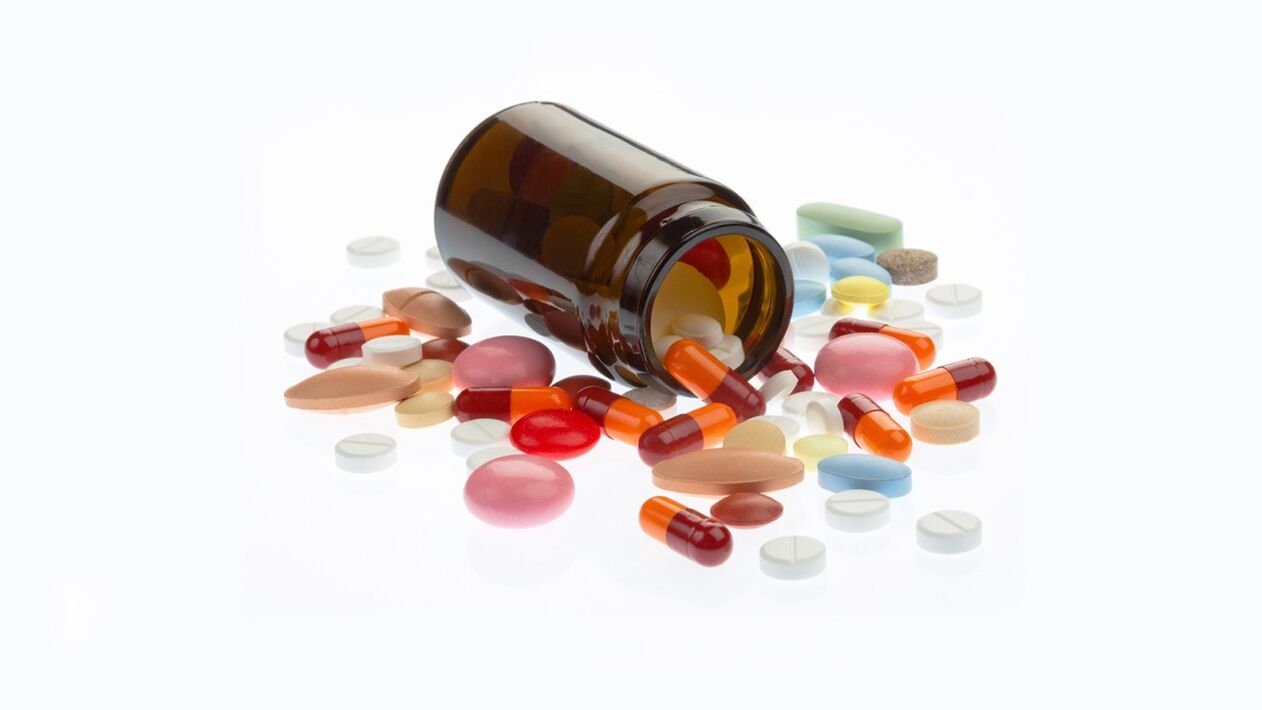
- A packet of butter (but not spread) butter should be put in a saucepan with crushed propolis (10 g). Put on the fire and cook for 15 minutes after boiling. Then - the mixture should be thoroughly filtered and allowed to cool. Keep this medicine in the refrigerator only. Method of application - rub into the affected area several times a day.
- In a clay bowl, grind fresh flowers of St. John's wort (20 g), celandine root, propolis, calendula flowers (10 g). Vegetable oil is added to the resulting mixture. Store in a cool place away from sunlight. Method of application - lubricate psoriasis eruptions 3 times a day.
- For half an hour, boil a liter of white wine, sea fish weighing more than three kilograms and shellfish over a low flame. Cool, strain, then add a glass of olive oil. Method of application - wash and dry the affected areas thoroughly with egg soap. After that, lubricate the elements with this mixture. The course of treatment is until the end of the drug.
- Thoroughly mix equal parts celandine powder and petroleum jelly (by weight). Method of application - the ointment is applied in a thin layer on the rash and left for up to three days. After that, you should take a short break of about 4 days. Treat until the psoriasis is completely gone.
- A tablespoon of vegetable oil is added to the beaten eggs (2 pieces). Whisk the mixture again, then apply acetic acid (40 g). Keep the ointment in a jar with a tight lid. Method of application - once a day, preferably at night, treat psoriasis eruptions.
- An equally effective and common remedy for the treatment of psoriasis is healing mud. The mud should be heated to 38 degrees and applied to the affected skin. This procedure should be done in the evening, preferably before bedtime. After 30 minutes, the dirt is removed with warm water. It is important to remember that all spills after dirt should be treated with saline. The body must be built up and excess salt must be shed. Sleep without washing or moisturizing the skin. And just lubricate the psoriasis elements with cream in the morning. The recommended course is 20 procedures (daily).
Although a popular method of treating psoriasis is chosen, it should be discussed with the attending dermatologist.























